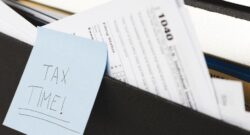Author: Igor Nastaskin
What Homeowners Should Know About Calculating Property Tax
Most people know that homeownership requires a monthly mortgage payment. But did you know that you’ll also have to pay property taxes? If you already own a home, you can see how your tax is calculated on your most current property tax statement. If you’re considering buying a home, look on the real estate listing for assessment and tax information, or go to the county website to find out the annual property tax. Note: Property taxes can change. The assessed value of your house can increase or decrease, depending on the local real estate market. Your assessment also can rise or fall depending on changes you make to your house, like additions to your property. And the tax rate can change depending on your local government. Although the government sends you a tax bill every year and tells you how much you owe in property taxes, it’s important to know how that tax is calculated. Numerous factors come into play when calculating property taxes, from your property’s assessed value to the mill levy (tax rate) in your area. Here’s how to determine what your property tax will be, so you don’t get blindsided by this large homeowner expense. What is a home’s fair market value? The market value of a home is basically the amount a knowledgeable buyer would pay a knowledgeable seller for a property, assuming an arms-length transaction and no pressure on either party to buy or sell. When a property sells to an unrelated party, the sales price usually is assumed to be the fair value of the property. What is a home’s assessed value? One factor that affects your property taxes is your property’s worth. You probably have a good understanding of your home’s market value—the amount of money a buyer would, hopefully, pay for your place. (You also could enter your address in a home value estimator to get a ballpark figure.) But tax municipalities use a slightly different number; it’s called your home’s assessed value. Tax assessors can calculate a home’s current assessed value as often as once per year. They also may adjust information when a property is sold, bought, built, or renovated by examining the permits and paperwork filed with the local municipality. They will look at basic features of your home (like the acreage, square footage, and number of bedrooms and baths), the purchase price when it changes hands and comparisons with similar properties nearby. A home’s assessed value sometimes will be strikingly similar to its fair market value, but that’s not always the case, particularly in heated markets. In general, you can expect your home’s assessed value to amount to about 80 percent to 90 percent of its market value. You can check your local assessor or municipality’s website, or call the tax office for a more exact figure for your home. You also can search by state, county and ZIP code on publicrecords.netronline.com. If you believe the assessor has placed too high a value on your home, you can challenge the calculation of your home’s value for tax purposes. You don’t need to hire someone to help you reduce your property tax bill. As a homeowner, you may be able to show how you determined that your assessed value is out of line. What is taxable value? The taxable value of your house is the value of the property according to your assessment, minus any adjustments such as exemption amounts. What’s a mill levy? In addition to knowing your home’s assessed value, you’ll need to know another number known as a mill levy. That’s the tax assessment rate for real estate in your area. The tax rate varies based on the public amenities offered and revenue required by local government. If you have a public school, police force, full-time fire department, desirable school districts, and plenty of playgrounds and parks, your property tax rates will be higher than a town without them. Your area’s property tax levy can be found on your local tax assessor or municipality website, and it’s typically represented as a percentage—like 4 percent. To estimate your real estate taxes, you simply multiply your home’s assessed value by the levy. So, if your home is worth $200,000 and your property tax rate is 4 percent, you’ll pay about $8,000 in taxes per year. Where to find property taxes In many cases, you may not have to calculate your own property taxes. You can often find the exact amount (or a ballpark figure) you’ll pay on listings, or you can enter a home’s location and price into an online home affordability calculator that not only will estimate your yearly taxes, but also how much you can anticipate paying for your mortgage, home insurance, and other expenses.
The Difference Between a Second Home and an Investment Property
You’ve probably heard the terms second home, investment property, vacation home and rental property. But is there any real difference among them? And does it even matter what you call it? Turns out there are some very big differences between second homes and investment properties, especially if you are seeking to finance them. Both are great ways to build wealth over time by capturing the appreciation of a real asset. However, they both come with risks and expenses that should be carefully considered when making a purchase. As with any real estate transaction, you’ll want to do your due diligence and make a smart choice for your wallet, no matter which path you choose. Here, the scoop on how a second home and investment property differ. What is a second home? A second home is a second property where you and your family spend time away from your primary home. You might also hear a second home referred to as a vacation property. You may rent it out for a few days a year on Airbnb or VRBO, but you primarily use it yourself. Buying a second home makes financial sense if there’s one particular vacation spot you visit regularly. Why spend a fortune on hotels or Airbnb when you can own your own piece of paradise that will hopefully appreciate in value over time? What is an investment property? An investment property, meanwhile, is one that you purchase with the main intention of generating income. The investment property could be next door to your own home or it could be in another state—it doesn’t really matter. You’ll be playing the role of landlord, with long-term or short-term renters paying cash to stay in the home. Before making an offer on an investment property, you’ll want to crunch the numbers to make sure it’s a solid investment. Similarly, consider what factors will be important to prospective tenants (like access to public transportation, good schools, parking and low crime rates). How to finance a second home or investment property If you need to secure a mortgage to purchase your new property, you should know that financing a second home or investment property is different from financing a primary residence. While mortgages on second homes and investment properties have some similarities, there also are some key differences. Interest rate: You can expect to see a higher interest rate for both second homes or investment properties than for primary homes. That’s because lenders view those transactions as riskier. If you get into a tight spot with money, you’re far more likely to stop paying the mortgage for your second/investment property than for your primary home. Qualifying: Whether you’re buying a second home or an investment property, you might need to do some extra legwork to qualify for that second loan. Your bank may require you to prove that you have healthy cash reserves (so it knows you can afford both mortgages). It’ll take a long, hard look at your overall financial situation, so be sure everything is in top order before you apply. Down payment: Depending on your situation and the lender, you also might need to bring a larger down payment to the table for an investment property or second home, typically 15 percent to 25 percent. Again, this is because the bank wants a bigger cushion to fall back on in case you default. Rental income: If you’re buying an investment property, your lender might allow you to show that anticipated rental income will help cover the mortgage payments. Proving how much rental income the home will generate can be complicated. Prepare to pay for a specialized appraisal that takes into account comparable rents in your area. Location: Your lender may require a second home to be 50 to 100 miles away from your primary home. An investment property, however, can be anywhere in comparison with your primary home, even next door. Taxes: Federal income tax rules are different for vacation homes and investment properties. You typically will treat your second home just as you would your first home when it comes to taxes—if you itemize, you can deduct the mortgage interest you paid up to a certain limit. (The rules vary if you rent out your second home for part of the year.) If you own an investment property, you can deduct the mortgage interest, plus many of the expenses that come with operating a rental business, but you also have to report your rental income. Why it’s important to not confuse the two It’s important not to use the terms “second home” and “investment property” interchangeably. Some people try to pass off their investment property as a second home to get more favorable financing, but you should never do this. If you misrepresent yourself on your loan application, you could be committing mortgage fraud, which is a federal offense. Your lender’s underwriting team is aware of this possibility, and they’ll take the big picture into account when deciding what loan terms to offer you. Bottom line: Keep everything aboveboard, and you won’t have to worry about a thing.








